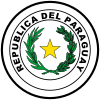Carlos Antonio López
This article has multiple issues. Please help improve it or discuss these issues on the talk page. (Learn how and when to remove these messages)
|
Carlos Antonio López | |
|---|---|
 | |
| 1st President of Paraguay | |
| In office March 13, 1844 – September 10, 1862 | |
| Vice President | Mariano González (1845–1846) Francisco Solano López (1862) |
| Preceded by | himself as Consul |
| Succeeded by | Francisco Solano López |
| Consul of Paraguay | |
| In office March 12, 1841 – March 13, 1844 | |
| Preceded by | Mariano Roque Alonso |
| Succeeded by | himself as President |
| Personal details | |
| Born | November 4, 1792 Asunción, Paraguay, Viceroyalty of the Río de la Plata, Spanish Empire |
| Died | September 10, 1862 (aged 69) Asunción, Paraguay |
| Political party | None |
| Spouse | Juana Pabla Carrillo |
| Children | Francisco Venancio Benigno Rafaela Inocencia |
Carlos Antonio López Ynsfrán (November 4, 1792 – September 10, 1862) was leader of Paraguay from 1841 to 1862.
Early life
López was born at Manorá (Asunción) on November 4, 1792, as one of eight children.[1] He graduated from Real Colegio y Seminario de San Carlos and then began a law practice, a profession which allowed him to develop influential connections.[2] He attracted the hostility of the dictator José Gaspar Rodríguez de Francia, his reputed uncle,[3] which caused him to go into hiding for several years.[4]
Political career

López was briefly secretary of the military junta led by Colonel Mariano Roque Alonso that ruled the country from 1840 to 1841, after the death of Francia. On March 12, 1841, Congress chose López and Roque to be joint consuls for three years.[2] In 1844, he exiled Roque and assumed dictatorial powers. A few months later, Congress adopted a new constitution, which changed the head of state's title from consul to president and elected López to the new post for a 10-year term.[1] The constitution vested López with powers almost as sweeping as those "El Supremo" had held for most of his 26-year rule, effectively codifying the dictatorial powers he had seized just months earlier. The document included no guarantees of civil rights; indeed, the word "liberty" was not even in the text.
He was re-elected for a three-year term in 1854 and again in 1857 for ten more years, with the power to nominate his own successor.[4][2]
His government was directed towards developing Paraguay's primary resource extraction and strengthening Paraguay's armed forces. He contracted numerous foreign technicians, most of whom were British, and built up the formidable Fortress of Humaitá.[5]
Before the constitution adopted in 1844 that legitimized López’s presidency, Paraguay had no official document of sovereignty; López’s influence led to the recognition of Paraguay as an independent nation.[1] However, his approach to foreign affairs several times involved him in diplomatic disputes with the Empire of Brazil, the United States, and the British Empire, which nearly resulted in war.[4] His government was somewhat more tolerant of opposition than Francia's had been. He released all political prisoners soon after he took full power and also took measures to abolish slavery.[6]
During his presidency, Paraguay’s economy saw unprecedented growth. He signed commercial treaties with Brazil in 1850, with Great Britain, France and the United States in 1853, and with and Argentina in 1856. His government worked to improve infrastructure and transportation within the country through the establishment of a new railroad line and steamship river routes. López also encouraged public education through the expansion of primary schools and the reopening of the seminary he attended as a young man, which increased literacy throughout the country.[1][2]
His eldest son, Francisco Solano López (1827–1870), succeeded him as president after his death.[2] A barrio of Asuncion is named after him.
See also
References
- ^ a b c d "Carlos Antonio López". Encyclopedia of World Biography. Vol. 9 (2nd ed.). Gale. 2004. pp. 506–507.
- ^ a b c d e Reber, Vera Blinn (2008). "López, Carlos Antonio (1792–1862)". In Kinsbruner, Jay; Langer, Erick D. (eds.). Encyclopedia of Latin American History and Culture. Vol. 4 (2nd ed.). Charles Scribner's Sons. pp. 254–255.
- ^ Bannon, John Francis; Dunne, Peter Masten (1950). Latin America, an Historical Survey. Science and culture texts (2 ed.). Bruce Publishing Company. p. 587. Retrieved 2016-02-25 – via Google Books.
[...] a wealthy creole landowner and reputed nephew of Francia, [...] Carlos Antonio Lopez.
- ^ a b c Chisholm 1911.
- ^ Plá.
- Williams. - ^ Cooney, Jerry W. (1997). "Paraguay". In Rodriguez, Junius P. (ed.). The Historical Encyclopedia of World Slavery. Vol. 2. ABC-CLIO. p. 492. ISBN 9780874368857. Retrieved 2016-02-25 – via Google Books.
The rise to power of Carlo Antonio López after Francia's death in 1840 brought a cautious, gradualist approach to the abolition of Paraguayan slavery. The government decreed a Law of Free Womb in 1842, which freed children born to slaves.
Sources
- This article incorporates text from a publication now in the public domain: Chisholm, Hugh, ed. (1911). "Lopez, Carlos Antonio". Encyclopædia Britannica. Vol. 16 (11th ed.). Cambridge University Press. p. 990.
- Plá, Josefina (1976). The British in Paraguay 1850–1870. The Richmond Publishing Co in association with St Antony's College, Oxford.
- Williams, John Hoyt (1977). "Foreign Tecnicos and the Modernization of Paraguay". Journal of Interamerican Studies and World Affairs. Center for Latin American Studies at the University of Miam: 233–257. doi:10.2307/174705. JSTOR 174705. (subscription required)
- Bealer, Lewis (1937). "Carlos Antonio Lopez, Organizer and Dictator of the Paraguayan Republic". In Wilgus, Alva (ed.). South American Dictators During the First Century of Independence. George Washington University Press. pp. 136–153. ISBN 9780846203391.
- Burton, Richard (1870). Letters from the Battlefields of Paraguay. Tinsley Brothers.
- Gelly, Andres (1926). El Paraguay. de Indias.



